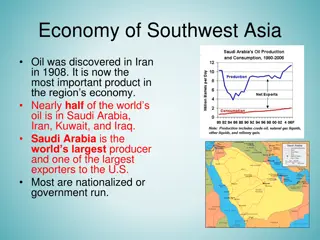Nationalism in India and Southwest Asia: A Historical Overview
The aftermath of World War I led to a surge in nationalism in India and certain Southwest Asian countries, as empires like the Ottoman Empire and the British Empire showed signs of weakening. Indian nationalism grew due to factors such as promises of reform by the British, religious divisions, and events like the Amritsar Massacre. Leaders like Gandhi played pivotal roles in advocating for independence through nonviolent means, uniting Hindus and Muslims in the struggle for freedom.
Download Presentation

Please find below an Image/Link to download the presentation.
The content on the website is provided AS IS for your information and personal use only. It may not be sold, licensed, or shared on other websites without obtaining consent from the author. Download presentation by click this link. If you encounter any issues during the download, it is possible that the publisher has removed the file from their server.
E N D
Presentation Transcript
NATIONALISM IN INDIA AND SOUTHWEST ASIA 30.4
SETTING THE STAGE WWI resulted in the Ottoman Empire being broken apart Also, because of the war, the British Empire which controlled India began to show signs of cracking The weakening of these empires led to increased nationalism in India, Turkey, and some Southwest Asian countries
INDIAN NATIONALISM GROWS Indian nationalism had been growing since the mid-1800s Many upper-class Indians who attended British schools learned European views of nationalism and democracy. They began to apply these political ideas to their own country The problem was India was divided based on religion (Hindus vs. Muslim) This led to the creation of the National Congress Party and Muslim League Their hatred for each other prevented them from uniting with a common goal of independence.
WHY DID FEELINGS OF NATIONALISM INCREASE? During WWI the British needed more soldiers so they turned to their colonies for help, including India In order to gain support the British promised that in return they would make changes to the government; giving the people more control over their own nation WWI ended but not changes came When the people protested the British Parliament passed the Rowlatt Acts against protests and public meetings which stated that protestors would be jailed without trial Problem is they never told the people about this act
AMRITSAR MASSACRE Without knowing this 10,000 people gathered in Amritsar to protest Instead of jailing the protesters, soldiers shot into the crowd killing several hundreds of people. Overnight it led to a huge switch in India from loyal subjects to revolutionists
WHAT WERE THREE REASONS FOR INCREASE OF INDIAN NATIONALISM?
GANDHIS TACTICS OF NONVIOLENCE Mohandas Gandhi became the leader of India s protest movement He had a deeply religious approach to political activity which blended teaching of Hinduism, Islam, and Christianity. This allowed him to unite both the Hindus and Muslims
GANDHIS TACTICS OF NONVIOLENCE After the Amritsar Massacre the officers went unpunished; to protest Gandhi organized a campaign of noncooperation with the British. He urged civil disobedience which is the deliberate and public refusal to obey an unjust law as well as nonviolence. He asked Indians to stop buying British goods, attending British schools, paying British taxes, or voting in British run elections. British jails filled with thousands of Indians who broke the laws in form of protest
SALT MARCH In the 13 colonies the colonist had to pay tea taxes In India they had to pay salt taxes To protest Gandhi organized a march to the seas to go make their own. This was followed by another march to the place where the government made salt Police officers with steel tipped clubs attacked the demonstrators
SALT MARCH An American journalist witnessed it and spread the word in newspapers across the world This helped Gandhi gain attention In 1935, the British finally gave in and passed a law the allowed Indian self- government In 1947 the Indians gained their independence from the British.
GANDHI, REAL SALTY Documentary clip Scene from film
NATIONALISM SPREADS TO SOUTHWEST ASIA The breakup of the Ottoman Empire and growing western political and economic interest in Southwest Asia spurred the rise of nationalism in this region At the end of WWI, the Ottoman Empire was forced to give up all its territories except Turkey
THE OTTOMAN EMPIRE The Greeks saw that they were weak and threatened to conquer it The sultan was powerless against the Greeks; Mustafa Kemal stepped in and successfully helped defeat the Greeks as well as keep the British out Eventually, as leader he took steps to modernize society and the economy in Turkey
PERSIA BECOMES IRAN Before WWI, both Britain and Russia had influence in Persia Britain tried to take control of all of Persia after the war This led to a nationalist revolt In 1921, Reza Shah Pahlavi, a Persian army officer seized power He established schools, built roads, and railroads, and promoted women s rights. He later changed the country s name to Iran
OIL DRIVES DEVELOPMENT Starting in the 1920s, Southwest Asia saw a major economic change and development Western companies discovered large resources of oil in several countries in this area Oil brought huge sums of money to these countries Western nations tried to gain power in the region so they could get some of this wealth.























